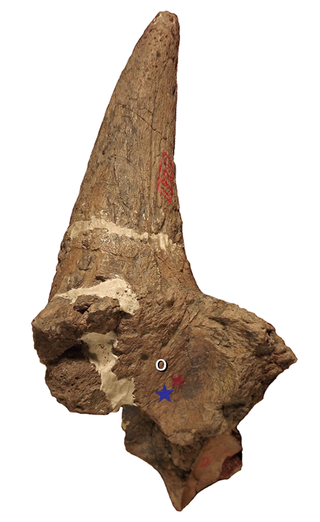
Entelodon, formerly called Elotherium, is an extinct genus of entelodont artiodactyl endemic to Eurasia. Fossils of species are found in Paleogene strata ranging in age from the Houldjinian until the Rupelian epoch of the early Oligocene.

Ceratops is a dubious genus of herbivorous ceratopsian dinosaur which lived during the Late Cretaceous. Its fossils have been found in the Judith River Formation in Montana. Although poorly known, Ceratops is important in the history of dinosaurs, since it is the type genus for which both the Ceratopsia and the Ceratopsidae have been named.

John James Stevenson was an American geologist, born in New York City. He graduated from New York University in 1863, became professor of chemistry at West Virginia University for two years (1869–71), then served as professor of geology at New York University until 1909. During 1873–74 and from 1878 to 1880 he was geologist for the United States Geological Survey. He also served on the Pennsylvania Geological Survey from 1875 to 1878 and from 1881 to 1882. He was president of the Geological Society of America in 1898.
Dolerorthis is an extinct genus of hesperorthid brachiopod. The type species of this genus, D. interplicata, was described from the Silurian (Telychian) Osgood Formation. Other species belonging to this genus are known from the Ordovician and Silurian of Europe, Kazakhstan, China and Argentina. It was roughly 4 centimetres (1.6 in) across.

Camarasaurus grandis is an extinct species of sauropod dinosaur in the genus that lived during the Jurassic in what is now the western United States. It is the geologically oldest of the four species of the genus Camarasaurus.
Theretairus is a Late Jurassic genus of sphenodont reptile from the Morrison Formation of western North America, present in stratigraphic zones 5 and 6.

Stegomosuchus is an extinct genus of small protosuchian crocodylomorph. It is known from a single incomplete specimen discovered in the late 19th century in Lower Jurassic rocks of south-central Massachusetts, United States. It was originally thought to be a species of Stegomus, an aetosaur, but was eventually shown to be related to Protosuchus and thus closer to the ancestry of crocodilians. Stegomosuchus is also regarded as a candidate for the maker of at least some of the tracks named Batrachopus in the Connecticut River Valley.

Agriochoerus is an extinct genus of scansorial herbivore of the tylopod family Agriochoeridae, endemic to North America. Agriochoerus and other agriochoerids possessed claws, which is rare within Artiodactyla, as well as likely being scansorial. Agriochoerus was first described in 1869.

"Crocodylus" affinis is an extinct species of crocodyloid from the Eocene of Wyoming. Fossils were first described from the Bridger Formation by American paleontologist Othniel Charles Marsh in 1871. Marsh described the species, along with every other species of crocodyloid in the Bridger Formation, under the genus Crocodylus. The known specimen of "Crocodylus" affinis is a skull found at Grizzly Buttes, Wyoming, measuring 13 inches in length on the upper surface. Recent phylogenetic studies of crocodyloids show that "C." affinis is not a species of Crocodylus, but a genus has not yet been erected to include the species. Other Bridger species such as Crocodylus clavis and Brachyuranochampsa zangerli have been synonymized with "C." affinis.
Indraloris is a fossil primate from the Miocene of India and Pakistan in the family Sivaladapidae. Two species are now recognized: I. himalayensis from Haritalyangar, India and I. kamlialensis from the Pothohar Plateau, Pakistan. Other material from the Potwar Plateau may represent an additional, unnamed species. Body mass estimates range from about 2 kg (4.4 lb) for the smaller I. kamlialensis to over 4 kg (8.8 lb) for the larger I. himalayensis.
(Henry) Guy Ellcock Pilgrim was a British geologist and palaeontologist. He was a Fellow of the Royal Society and Superintendent of the Geological Survey of India, and made significant contributions to Cenozoic continental stratigraphy and vertebrate palaeontology.

The Ludlowville Formation is a geologic formation in New York, Ohio and Pennsylvania. It dates to the Devonian period.
Idiognathodontidae is an extinct conodont family.
Dhirendra Kishore Chakravarti was an Indian geologist and palaentologist, who worked at Banaras Hindu University in the Geological Museum.

Cavusgnathus is an extinct genus of conodonts.
Hyperailurictis is an extinct genus of felid from Miocene North America. The Hyperailurictis species are Pseudaelurus-grade felids and thought to be the first felids in the Americas.
Phrynops paranaensis is an extinct species of turtle from the Huayquerian Ituzaingó Formation of the Paraná Basin, Argentina, likely to be late Miocene in origin.
Uintasorex is a genus of primate which lived in North America during the Eocene epoch. Fossils belonging to Uintasorex have been dated to the Bridgerian and Uintan stages, roughly 50.3 to 42 million years ago.
Clarence Norman Fenner was an American geologist who specialized in petrology, particularly the transformations of silica minerals. One of his innovations in geology was the use of modified variation diagrams based on those introduced by Alfred Harker which are sometimes referred to as "Fenner-type variation diagrams".
Pleurostylodon is an extinct genus of notoungulate belonging to the family Isotemnidae. It lived during the Middle Eocene, in what is now Argentina.










